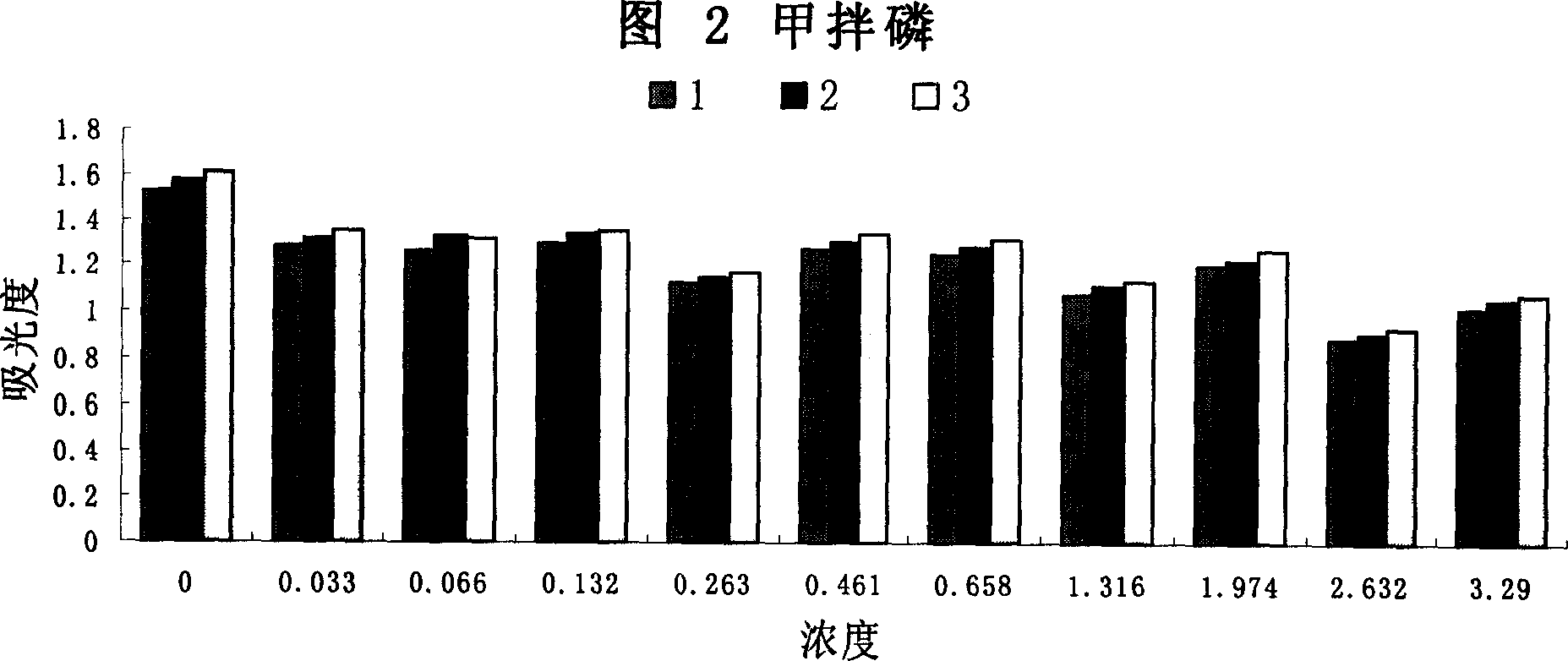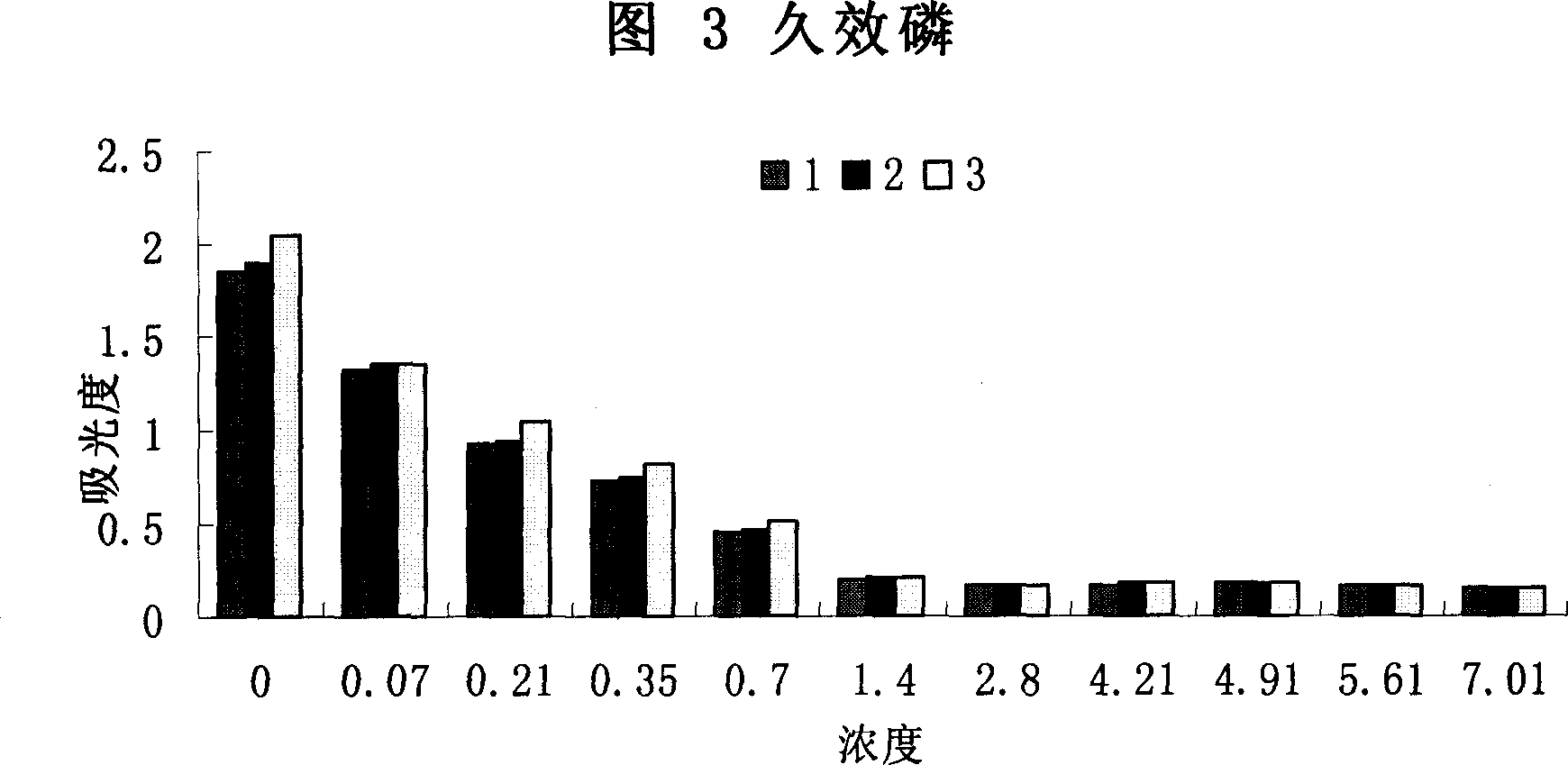Quick detection method for agricultural chemical residue in milk
A detection method and technology for pesticide residues are applied in the field of rapid detection of pesticide residues in animal milk and dairy products, achieving the effects of simple instrument, reduced laboratory workload and simple operation.
- Summary
- Abstract
- Description
- Claims
- Application Information
AI Technical Summary
Problems solved by technology
Method used
Image
Examples
Embodiment 1
[0036] Rapid detection experiment and detection limit verification of dichlorvos pesticide residues in milk
[0037] Experimental pesticide: Dichlorvos:
[0038] mouse oral LD 50 50-92mg / kg; rat oral 50-110mg / kg.
[0039] 10 concentrations were used in the experiment, and the test results were repeated three times (Fig. 1).
[0040] The obtained inhibition rates of different concentrations are listed in Table 1 below, and Figure 1 is drawn according to the obtained inhibition rates.
[0041] Experimental steps:
[0042] 1. Take the test samples of different concentrations of pesticides and acetone in an appropriate ratio, mix and shake, and let stand for 10 minutes until the supernatant appears.
[0043] 2. Take 5ml of the supernatant and place it in a colorimetric tube, blow it with nitrogen and concentrate until there is no solvent.
[0044] 3. Add 2 mL of phosphate buffer solution with a pH of 8.0 to the above colorimetric tube, then add 40 μL of cholinesterase ...
Embodiment 2
[0057] Rapid detection experiment and detection limit verification of methamidophos pesticide residues in milk
[0058] Experimental pesticide: Methamidophos:
[0059] Methamidophos acute toxicity: oral LD in rats 50 7.5mg / kg; rats inhaled LC 50 9mg / kg; rat percutaneous LD 50 : 50mg / kg.
[0060] Methamidophos designed 10 concentration gradients, and the experimental results were repeated three times (Fig. 2).
[0061] Experimental steps:
[0062] 1. Take the test samples of different concentrations of pesticides and acetone in an appropriate proportion, mix and shake, and let stand for 20 minutes until the supernatant appears.
[0063] 2. Take 7.5ml of the supernatant and place it in a colorimetric tube, blow in nitrogen gas, and concentrate until there is no solvent.
[0064] 3. Add 3 mL of phosphate buffer solution with a pH of 7.0 to the above colorimetric tube, then add 50 μL of cholinesterase and 50 μL of chromogenic reagent dithio-dinitrobenzoic acid (DTN...
Embodiment 3
[0077] Rapid detection experiment and detection limit verification of monocrotophos pesticide residues in milk
[0078] Experimental pesticide: Monocrotophos:
[0079] mouse oral LD 50 5mg / kg; rat oral LD 50 21mg / kg; Rabbit percutaneous LD 50 149~709mg / kg
[0080] Using 10 concentrations, the test results were repeated three times (Fig. 3).
[0081] Experimental steps:
[0082] 1. Take the test samples of different concentrations of pesticides and acetone in an appropriate proportion, mix and shake, and let it stand for 30 minutes until the supernatant appears.
[0083] 2. Take 10ml of the supernatant and place it in a colorimetric tube, blow in nitrogen gas, and concentrate until there is no solvent.
[0084] 3. Add 4 mL of phosphate buffer solution with a pH of 7.5 to the above colorimetric tube, then add 60 μL of cholinesterase and 60 μL of chromogenic agent dithio-dinitrobenzoic acid (DTNB); A control group with the same processing steps as the sample grou...
PUM
 Login to View More
Login to View More Abstract
Description
Claims
Application Information
 Login to View More
Login to View More - R&D
- Intellectual Property
- Life Sciences
- Materials
- Tech Scout
- Unparalleled Data Quality
- Higher Quality Content
- 60% Fewer Hallucinations
Browse by: Latest US Patents, China's latest patents, Technical Efficacy Thesaurus, Application Domain, Technology Topic, Popular Technical Reports.
© 2025 PatSnap. All rights reserved.Legal|Privacy policy|Modern Slavery Act Transparency Statement|Sitemap|About US| Contact US: help@patsnap.com



